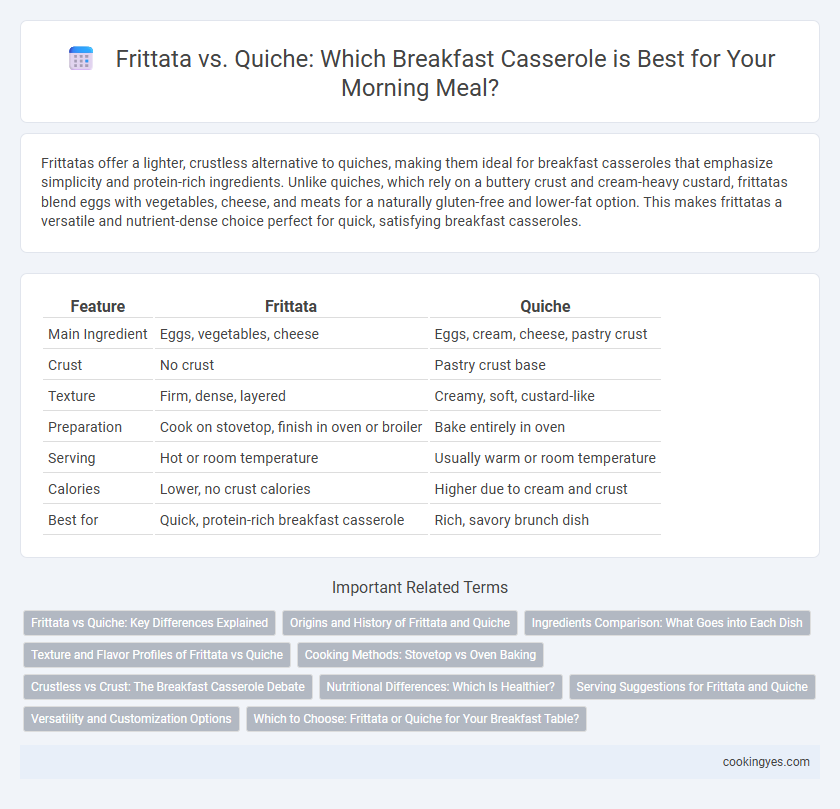Frittatas offer a lighter, crustless alternative to quiches, making them ideal for breakfast casseroles that emphasize simplicity and protein-rich ingredients. Unlike quiches, which rely on a buttery crust and cream-heavy custard, frittatas blend eggs with vegetables, cheese, and meats for a naturally gluten-free and lower-fat option. This makes frittatas a versatile and nutrient-dense choice perfect for quick, satisfying breakfast casseroles.
Table of Comparison
| Feature | Frittata | Quiche |
|---|---|---|
| Main Ingredient | Eggs, vegetables, cheese | Eggs, cream, cheese, pastry crust |
| Crust | No crust | Pastry crust base |
| Texture | Firm, dense, layered | Creamy, soft, custard-like |
| Preparation | Cook on stovetop, finish in oven or broiler | Bake entirely in oven |
| Serving | Hot or room temperature | Usually warm or room temperature |
| Calories | Lower, no crust calories | Higher due to cream and crust |
| Best for | Quick, protein-rich breakfast casserole | Rich, savory brunch dish |
Frittata vs Quiche: Key Differences Explained
Frittatas are an Italian-style omelet made primarily from beaten eggs mixed with vegetables, cheese, and meats, cooked slowly and finished without a crust, emphasizing a dense, fluffy texture. Quiches originate from French cuisine and include a rich custard mixture of eggs and cream poured into a pastry crust, creating a creamy, buttery base that is baked until set. The main differences lie in the crust presence, moisture content, and cooking techniques, making frittatas lighter and quiches richer and more pastry-focused.
Origins and History of Frittata and Quiche
Frittata, with roots in Italian cuisine dating back to the 16th century, is a traditional egg-based dish often enriched with vegetables, meats, or cheeses and cooked slowly on the stovetop or in the oven. Quiche originated in the Lorraine region of France in the 16th century, characterized by a savory custard filling baked within a flaky pastry crust, showcasing regional ingredients like bacon and cream. Both dishes evolved as versatile breakfast casseroles, with frittata embracing a crustless, rustic preparation and quiche maintaining a delicate, structured tart form.
Ingredients Comparison: What Goes into Each Dish
Frittatas primarily consist of beaten eggs mixed with vegetables, cheeses, and sometimes meats, cooked without a crust, emphasizing fresh, whole ingredients and simplicity. Quiches include a rich custard base made from eggs and cream or milk, combined with similar fillings like cheese, vegetables, and meats, all encased in a buttery, flaky pastry crust that provides texture and structure. The key difference lies in the creamy custard and crust of quiche versus the denser, egg-forward, crustless composition of a frittata.
Texture and Flavor Profiles of Frittata vs Quiche
Frittata offers a dense, fluffy texture with a rich, egg-forward flavor that intensifies as it cools, creating a savory, satisfying bite. Quiche features a delicate, creamy custard filling with a buttery, flaky crust, combining smoothness with a crisp edge for a lighter mouthfeel. The robust egginess of frittata contrasts with quiche's balanced blend of eggs, cream, and pastry, making each ideal for distinct breakfast casserole experiences.
Cooking Methods: Stovetop vs Oven Baking
Frittatas are primarily cooked on the stovetop, starting by gently cooking the ingredients before finishing under the broiler or transferring to the oven to set the eggs, resulting in a tender, fluffy texture. Quiches rely entirely on oven baking, with a pastry crust that bakes alongside a custard-like egg mixture, creating a firm and sliceable breakfast casserole. The stovetop method of frittatas allows for quicker cooking and easy incorporation of vegetables and cheese, while quiches require longer baking times to ensure the crust is crisp and the filling is fully cooked.
Crustless vs Crust: The Breakfast Casserole Debate
Frittatas offer a crustless option for breakfast casseroles, providing a lighter, protein-rich dish without the added carbs of a crust. Quiches typically feature a buttery, flaky crust that adds texture and richness but increases calories and carbohydrates. Choosing between frittata and quiche depends on dietary preferences, with frittatas favoring low-carb and gluten-free diets, while quiches appeal to those seeking a more indulgent breakfast casserole experience.
Nutritional Differences: Which Is Healthier?
Frittatas are generally lower in carbohydrates and calories compared to quiches due to the absence of a pastry crust, making them a lighter option for breakfast casseroles. Quiches often contain higher fat and sodium levels because of the buttery crust and added dairy like cream or cheese. For a healthier choice, frittatas provide more protein and fewer processed ingredients, supporting better weight management and heart health.
Serving Suggestions for Frittata and Quiche
Frittatas are best served warm or at room temperature, often sliced into wedges and paired with fresh salads or roasted vegetables, enhancing their rich, egg-based texture. Quiches are typically enjoyed warm, complemented by light sides like fruit or green salad, which balance their creamy, custard-like filling. Both dishes offer versatile serving options, making them ideal for breakfast or brunch gatherings.
Versatility and Customization Options
Frittatas excel in versatility and customization, allowing endless combinations of vegetables, cheeses, and meats without requiring a crust. Unlike quiches, which rely on a pastry base and custard filling, frittatas have a lighter texture and can be adapted for low-carb or gluten-free diets. This makes frittatas ideal for quick, flexible breakfast casseroles that cater to diverse dietary preferences and ingredient availability.
Which to Choose: Frittata or Quiche for Your Breakfast Table?
Frittata offers a lighter, crustless option rich in eggs, vegetables, and cheese, making it ideal for a quick, protein-packed breakfast casserole that's easy to customize. Quiche includes a buttery pastry crust with a creamy custard filling, providing a richer, more indulgent texture suited for special occasions or guests. Choose a frittata for a healthier, low-carb meal and quiche when craving a decadent, savory dish with a flaky crust.
Frittata vs Quiche for Breakfast Casseroles Infographic

 cookingyes.com
cookingyes.com